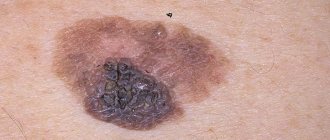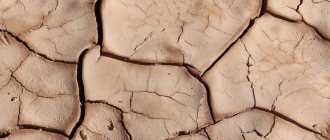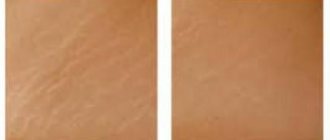Hyperkeratosis is a thickening of the outer layer of the skin. It is formed in response to skin injury as a protective reaction or when the process of epidermal cell division is disrupted against the background of certain skin diseases. The rough layer consists of keratin protein, which has rigidity and high strength.
This protein protects underlying cells from damage. When there is inflammation, irritation or mechanical pressure on certain areas, the production of keratin in them increases.
Kinds
Manifestations of hyperkeratosis form on the legs, arms, torso, scalp, palms, and feet. Their location and appearance depend on the reasons for their appearance.
The most common types of thickenings are:
- Calluses, corns on the soles of the feet and palms. Formed in areas subject to prolonged friction or pressure;
- Actinic keratosis. Develops due to excessive exposure of the skin to ultraviolet rays. Appears as flat, rough patches of yellow, brown or red color;
- Follicular hyperkeratosis (“goose bumps”). This is a rash of small multiple tubercles on the face, shoulders, legs, and buttocks. It is caused by a violation of the exfoliation of dead skin particles. This form of hyperkeratosis occurs in children; it goes away on its own in adolescence;
- Warts. Occurs when infected with the human papillomavirus. They appear as convex growths of various shapes and sizes. On the feet they are called plantar warts;
- Under nail hyperkeratosis. This is a thickening of the skin in the area of the nail bed, nail folds, which is caused by injuries, psoriasis, and onychomycosis. It leads to lifting, bending, and deformation of the nail plate.
You can see what different types of hyperkeratosis look like in the photo on the Internet. Its manifestations also include skin changes in certain skin diseases - eczema, psoriasis, lichen planus, seborrhea.
Why do gold rings turn your fingers black?
Let's see what is the reason why gold rings turn your fingers black. You may be a little upset by some of the revelations.
In fact, if your finger turns black from a ring, there are only two objective reasons: oxidation (or other transformation) of the metal or contamination. All other options either represent variations of the first two, or carry a clear shade of mysticism.
Let's start with the fact that gold is a noble metal, which means it is resistant to a huge range of chemical compounds. Gold in its pure form reacts only to the most aggressive alkalis and acids, which are not used in everyday life. Consequently, a ring made of pure gold cannot leave black marks a priori. Unless, of course, it's dirty.
Gold ring with cubic zirconia from the “Elegant Classics” collection (go to the SUNLIGHT catalog)
But there is a small nuance: rings (as well as other jewelry) are not made of pure gold. The noble metal is incredibly soft, which limits its scope of application. Pure aurum is used, perhaps, for the production of measured ingots and the thinnest sheets of gold leaf.
In the production of jewelry, special alloys are used, which include gold and other metals. The gold content is reflected in the hallmark: the smaller the sample, the lower the percentage of precious metal content.
Alternative metals that are added to gold are called alloys. Yellow and red gold usually contain silver and copper in varying proportions; white gold usually contains nickel or palladium.
It is copper and nickel that provide the appearance of those ugly black marks left on the fingers from the rings. These are the remains of patina resulting from oxidation and other chemical processes.
The most common alloy used for the manufacture of mass-produced jewelry is 585 gold (the optimal combination of aesthetics and performance characteristics). Under normal operating conditions it should not leave any marks on your fingers.
So if the finger on your hand turns black from a gold ring, most likely there is not enough gold in it or there is no gold at all. There is a lot of copper in this ring, so it is oxidized.
In white gold, the problem metal is often nickel. According to regulations, the use of nickel in jewelry is limited. It is increasingly being replaced by more expensive and inert palladium, which increases the price of jewelry.
Additional initiating factors are:
- Poor quality water. Unfortunately, what flows from our water taps cannot be called clean water. There are a large number of chemicals that negatively affect not only our skin, but also our favorite jewelry.
- Cosmetics and hygiene products. High-quality cosmetics, gels and soaps should theoretically not have a negative effect on precious metals, but with constant contact with them, a not very high-quality alloy can “give” the skin blackness.
- Household and other chemicals. Here we are talking about harsher chemistry: not only about mild dishwashing detergent or laundry soap, but also about chlorine-containing compounds for washing plumbing fixtures. What can we say about the chemicals manipulated by summer residents and garage workers!
- Profuse sweating. During training, heavy physical labor and on hot days, sweating increases. Our sweat contains caustic chemical compounds that negatively affect ligatures.
- Poor health. If a person is sick, the composition of sweat changes. It becomes more corrosive, so its effect on the metal becomes more pronounced.
- Improper storage of jewelry. Usually, dark marks remain after low-grade jewelry that has been exposed to moisture and temperature changes for a long time.
A ring made of high-grade gold, purchased at a second-hand store or pawn shop, may leave pronounced dark marks. Most likely, these are the remains of the polishing compound that was used for pre-sale preparation (polishing) of the product.
All other factors are associated with banal contamination, that is, the dark mark is left not by the ring, but by everything that gets clogged under it. These can be the same cosmetics and detergents, grease residues after cooking and washing dishes, soil after working in the garden, and even microparticles of city smog or smoke from a barbecue.
Why does it happen?
Hyperkeratosis is provoked by chronic inflammatory processes on the skin, infections, ultraviolet radiation, and exposure to aggressive chemicals. If the thickening has formed without prior irritation or injury, then it is probably caused by hereditary diseases.
Under the influence of external factors, and not internal diseases, hyperkeratosis most often affects the feet.
This is facilitated by:
- improperly selected shoes (tight, chafing, inappropriate in size, with heels, made of artificial materials);
- being overweight or tall, creating a lot of pressure on the foot;
- foot deformities (flat feet, club feet), gait disturbances;
- diabetes mellitus with loss of pain, tactile sensitivity of the lower extremities, impaired nutrition of foot tissues;
- fungal infection;
- deficiency of vitamins, minerals;
- dry skin;
- injuries;
- standing for long periods of time during the day.
A rather unpleasant, painful condition is hyperkeratosis on the heels. It leads to disruption of the integrity of the skin, the formation of cracks, and limits physical activity and ability to work.
On the skin of the hands, the cause of hyperkeratosis is often sports training (exercises on the horizontal bar, uneven bars, lifting weights, playing tennis, badminton), playing musical instruments (guitar). And also work without protective gloves in the garden, features of the profession (carpenter, painter, mechanic).
Silver and other metals
With silver, the story is almost the same as with gold: pure silver and its high-grade alloys should not leave dark marks on the fingers.
If a silver ring turns your finger black, it means that a not very high-grade alloy was used in its manufacture. Most likely, it contains a lot of copper or contains completely undesirable zinc or lead.
Rings made of copper and bronze are in fashion now. If they leave dark marks on the skin, this is completely normal. Moreover: it is believed that in this way copper has a beneficial effect on the body.
Silver ring with cubic zirconia (go to the SUNLIGHT catalogue)
When making jewelry from silver and white gold, rhodium plating technology (applying a thin layer of rhodium) is sometimes used. Such jewelry acquires a radiant shine, increased durability and never leaves black marks on the skin.
What to do if a silver or gold ring turns black?
If your silver ring has turned black, you need to clean it up immediately. A blackened silver ring on your finger can be restored to its original appearance at home, without resorting to the services of a jewelry workshop.
There are a lot of gentle cleaning products that are likely to be found in any housewife’s arsenal: ammonia, soda and foil, food vinegar, and so on. But if you really want, you can get a special product for caring for jewelry: from the time-tested penny GOI paste to more modern and expensive cleaning compounds.
Black magic is often blamed for blackening silver on a finger. Allegedly, the person was jinxed or was deliberately damaged - that’s why the energy field protecting him turned black. Therefore, it is not surprising that the owner of the blackened jewelry subsequently falls ill.
What is most interesting is that there is a rational grain in this sign, explainable from a scientific point of view. The fact is that when a person gets sick, his hormonal levels change and his natural secretions contain more sulfur. Sulfur has a detrimental effect on silver: it becomes covered with a layer of sulfide, which forms a thin black film.
Silver ring in the SUNLIGHT catalog
Blackening of silver, especially high-grade silver, is a serious signal from the body about danger transmitted through the jewelry. You may not believe in all kinds of damage and evil eyes, but it is necessary to undergo examination by a doctor.
But if the gold ring turns black on your finger, there can only be two options, which we have already mentioned. This is either a low gold content in the alloy, or banal dirt.
Prevention
To prevent the skin on your fingers from drying out and cracking, it is necessary to take preventive measures. To prevent the problem from returning again, it is recommended to use the following tips:
- Do not use cleaning products with aggressive components, such as alkali. Buy soap and gel without this additive.
- After washing your hands, you should dry them with napkins or a towel, and not dry them with hot air. It destroys the natural fatty “lubricant” of the dermis.
- Dirty work must be done with gloves. Use thin latex ones for cleaning the house, and thick cotton ones for repairs and work in the garden.
- Carry out hand care daily, treat your hands with creams in winter and summer: in winter - nourishing, and in summer - protective moisturizing.
- Eat balanced food enriched with essential vitamins and elements. Avoid vitamin deficiency. Drink more water and do not use a mono-diet for weight loss. Include nuts, vegetables and fruits, cottage cheese, beef and vegetable oils in your diet.
- Every six months, take multivitamin complexes for 30 days.
It is also necessary to examine the dermis on the fingers daily and begin treatment procedures on time. If the problem has gone far, then it is better to contact a specialist for help.
Methods of therapy
The doctor will determine exactly how to treat the problem in order to completely eliminate unpleasant manifestations. For diagnosis and treatment, you need to contact a dermatologist, as well as your specialist who deals with chronic disease.
The treatment uses only complex therapy, which, through joint efforts, including medications, traditional medicine and healthy nutrition, helps eliminate the problem. Along with the use of these treatment methods, it is necessary to limit work with chemical mixtures and more often pamper your hands with moisturizing cosmetics.
An important role in eliminating troubles is played by the intake of vitamins and microelements into the body. Therefore, the menu should be correct and balanced, rich in foods rich in calcium, vitamin E, A.









